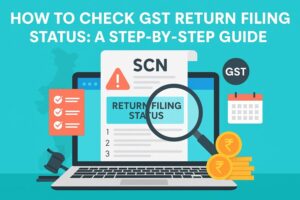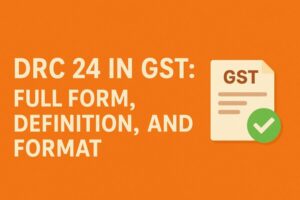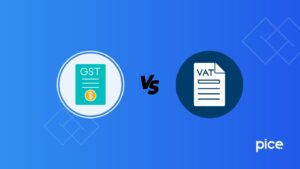Time, Place and Value of Supply Under GST
- 17 Oct 24
- 11 mins

Time, Place and Value of Supply Under GST
Key Takeaways
- Time of supply determines when tax payment becomes due for a transaction.
- Place of supply identifies if IGST, CGST, or SGST applies based on the supply location.
- Value of supply is key to calculating the correct GST amount for goods and services.
- Accurate invoices rely on understanding the time, place, and value of supply under GST.
- Proper knowledge of supply rules ensures accurate GST returns and compliance.
The time, place and value of supply under GST are some of the factors that determine the right tax rates payable on a business transaction. The taxpayers must have a clear understanding of the rates for CGST, SGST and IGST to issue GST-compliant invoices and to compute the taxes correctly. These invoices are essential for the proper filing of GST returns and maintaining accurate GST compliance with regulations.
This blog explains the rules and provisions that guide the time, place, and value of supply under GST, highlighting their importance, critical concepts for businesses and taxpayers.
Why Is the Time, Place And Value of Supply Important?
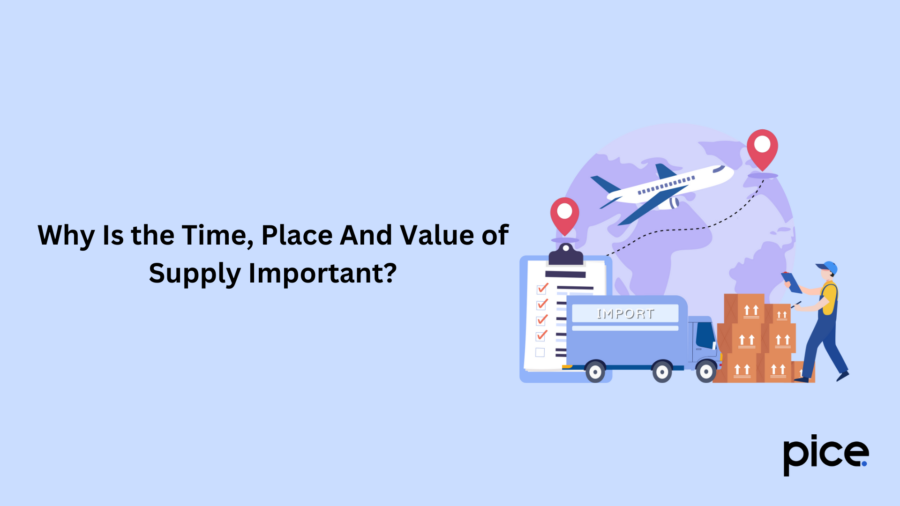
The following explains why time, place and value of supply are essential under GST:
- Time of Supply: It is the moment when goods or services are meant to be supplied. Knowing the time of supply helps the seller determine the due date for payment of taxes.
- Place of Supply: This helps in deciding whether IGST, CGST or SGST applies by identifying where the supply takes place.
- Value of Supply: GST is calculated based on the transaction's value. An incorrect value leads to errors in the GST amount charged.
What Is the Meaning of Time of Supply?
Time of supply refers to the time when goods or services are considered to have been delivered or sold. It helps the seller determine the GST filing deadline. The seller must pay CGST, SGST or IGST based on the time of issue. The rules for identifying the time of supply differ for goods and services. For goods, it is the earliest of the following:
- Issue of invoice date
- Date the payment or advance is received
- Last date by which the invoice issue should have been done
Suppose you sold goods worth ₹50,000 to Ms. XYZ. You issued an invoice on May 15, 2024, and received the payment on May 31, 2024. The goods were delivered on May 20, 2024.
According to the time of supply rules, you need to consider the earliest of these dates:
- Invoice date: May 15
- Payment date: May 31
- Last date for issuing the invoice: May 20
Therefore, the time of supply for this sale would be May 15, 2024.
- Time of Supply of Goods
Specific rules govern the time of supply for goods under GST. These rules are as follows:
- Date of Invoice
According to Section 31 of the CGST Act, 2017, the time of supply is the earlier of the two:
- The date the invoice is issued or the last possible date for the issue of invoice.
- The date when payment is received.
This applies when goods are supplied with an invoice. If the invoice is not issued within the prescribed time, the time of supply becomes more complicated.
- Date of Removal
When goods are sent for delivery, the time of supply is based on the date of removal. This rule is mainly relevant when the goods involve movement.
- Date of Delivery
If the goods are not physically moved, the time of supply is considered the date the goods are delivered to the recipient.
- Continuous Supply
In cases of continuous supply of goods, the time of supply is determined by the completion of the event that triggers the supply, such as the receipt of goods or when the recipient records the supply in their accounts, whichever is earlier.
- Unregistered Recipient
When goods are supplied to an unregistered recipient under reverse charge, the time of supply is when the recipient receives the goods.
- Time of Supply for Services
The time of supply for services under GST is subject to different regulations compared to goods. Here is how it works:
- Date of Invoice
For services, the time of supply is the earlier of two dates:
- The date the invoice is issued or the last date it should have been issued.
- The date when payment is received.
If an invoice is issued late, the time of supply is the date the payment is received. - Continuous Supply of Services
Similar to goods, the time of supply for continuous services is determined by the completion of the event triggering the supply or when the recipient records the service in their books, whichever is earlier.
- Reverse Charge Mechanism
If services are supplied by an unregistered person to a registered person, the time of supply is the date on which the service is received by the recipient. In this case, the reverse charge is met and the registered recipient is liable for the GST payment.
- Completion of Services
For services that are completed before an invoice is issued, the time of supply will be based on when the services are completed.
- Time of Supply Under Reverse Charge
Under the reverse charge mechanism, the responsibility to pay GST (CGST / SGST / UTGST / IGST) falls on the recipient of goods or services, instead of the supplier. The time of supply, or when the GST liability arises, is determined based on specific conditions.
- Time of Supply for Goods
GST on goods under reverse charge becomes due at the earliest of these events:
- Date of Receipt of Goods
The date when the goods are actually received by the buyer.
- Date of Payment
This is either the date when the payment is recorded in the buyer's books or the date when the payment is credited to their bank account, whichever happens first.
- 30 Days From Invoice Date
If the GST payments have not been made within 30 days of the supplier issuing the tax invoice, the liability arises the day after the 30-day period ends indicating 60 days for services.
If none of these can be determined, the time of supply will be the date the transaction is recorded in the buyer's books.
- Time of Supply for Services
For services, GST liability under reverse charge arises at the earliest of the following:
- Date of Payment
The earliest date between the payment being entered into the recipient’s accounts or credited to the bank.
- 60 Days From Invoice Date
If the recipient has not paid the service provider within 60 days of the invoice, the liability arises the day after the 60-day period expires.
What Is the Meaning of Place of Supply?
The place of supply is important for deciding which timely tax payments apply and whether a transaction is intra-state or inter-state. Here are the rules for the place of supply of goods and services under GST:
- Place of Supply of Goods
In most of the circumstances, the place of supply of goods is where the goods are being delivered. In other words, it describes the point at which the legal custody of the product transfers to the consumer.
However, when the goods are stationary, the place of supply is where the goods are situated at the time of delivery. But when the goods are assembled or installed, the place of supply is the place of assembly or installation.
For goods that are supplied through a conveyance, the place of supply is where the goods are located when they are being loaded on the conveyance. If the supply relates to imported goods, then the place of supply of the service is the place of the importer. In relation to exported goods, the place of supply is the place from which such goods are exported to other countries.
Suppose, a supplier from Kolkata sends machinery to a recipient in Delhi, and the machinery is installed at the recipient's factory in Kanpur, the place of supply will be Kanpur.
- Place of Supply for Services
In most cases, the place of supply for services is where the service recipient is located. If the recipient is an unregistered dealer or their location is unknown, the place of supply will become the provision of service. For services related to immovable property, the place of supply is where the property is located.
Special rules apply to certain services such as:
- Services related to immovable property
- Restaurant services
- Admission to events
- Transportation of goods and passengers
- Telecom services
- Banking, financial operations, and insurance services
Suppose, Mr. ABC from Delhi provides interior design services to Mr. XYZ from Mumbai for a property located in Ooty, Tamil Nadu, the place of supply will be Ooty.
What Is the Meaning of the Value of the Supply of Goods or Services?
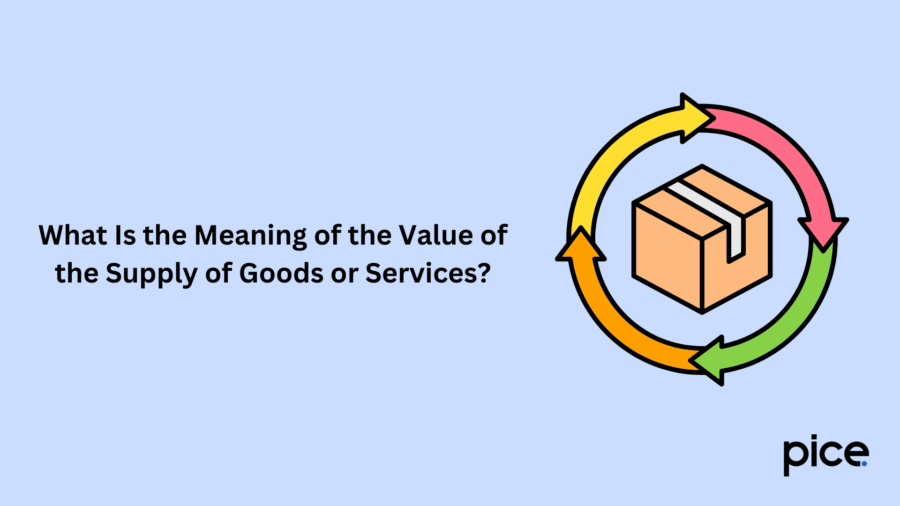
The value of supply is the total amount that a seller charges for the goods or services they provide. In situations where the parties involved are related, or the transaction happens through barter or exchange, GST law requires that the value on which GST is calculated must be its ‘transactional value’. It is important to calculate this value accurately because it forms the basis for determining the correct GST amount.
Importance of Value of Supply
The value of supply plays a key role in the GST system:
- Tax Calculation: The value of supply helps in determining the applicable GST rate and calculating the correct tax liability.
- Consistency: A standardised approach to calculating the value of supply ensures fairness and transparency in the taxation process.
Methods to Calculate the Value of Supply
There are several ways to determine the value of supply under GST:
- Transaction Value: This is the most common method, where the actual price paid for goods or services, including additional charges, is considered.
- Open Market Value: If the transaction value cannot be determined, the value is based on the open market value of similar goods or services.
- Value of Similar Supplies: When open market value is unavailable, the value is based on similar supplies, adjusted for relevant factors.
- Cost-Plus Method: For services, the value is calculated by adding a percentage to the supplier’s cost.
Impact on Businesses
Understanding the value of supply has several impacts on businesses:
- Accurate Tax Assessment: Correct calculation of the value of supply ensures businesses pay the right amount of tax, avoiding any errors.
- Input Tax Credit (ITC): Accurate value determination helps in claiming ITC on the taxes paid.
- Standardisation: Using standardised methods ensures that similar supplies are treated the same way, preventing confusion and disputes.
Conclusion
The time of supply, place of supply and value of supply under GST are vital characteristics that can ultimately determine the aspect of tax compliance and tax obligation. Knowledge of these elements is useful to normal taxpayers as well as to businesses for submitting accurate GST returns and avoiding noncompliance with the rules.
💡If you want to streamline your payment and make GST payments, consider using the PICE App. Explore the PICE App today and take your business to new heights.
 By
By 






